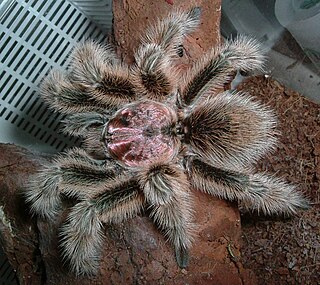
Grammostola is a genus of South American tarantulas that was first described in text by Eugène Louis Simon in 1892. These medium- to large-sized spiders are native to tropical South America, and are usually brown in color, with pinkish or orangish-red hairs. The very docile Chilean rose tarantula is popular as a beginner's spider among tarantula enthusiasts.

Idiopidae, also known as armored or spiny trapdoor spiders, is a family of mygalomorph spiders first described by Eugène Simon in 1889.

Barychelidae, also known as brushed trapdoor spiders, is a spider family with about 300 species in 39 genera.

Pterinochilus is a genus of baboon spiders that was first described by Reginald Innes Pocock in 1897. They are found all throughout Africa.

Ceratogyrus is a genus of tarantulas found in southern Africa. They are commonly called horned baboons for the foveal horn found on the peltidium in some species.

Tarantulas comprise a group of large and often hairy spiders of the family Theraphosidae. As of December 2023, 1,100 species have been identified, with 166 genera. The term "tarantula" is usually used to describe members of the family Theraphosidae, although many other members of the same infraorder (Mygalomorphae) are commonly referred to as "tarantulas" or "false tarantulas". Some of the more common species have become popular in the exotic pet trade. Many New World species kept as pets have setae known as urticating hairs that can cause irritation to the skin, and in extreme cases, cause damage to the eyes.
Batesiella is a monotypic genus of African tarantulas containing the single species, Batesiella crinita. It was first described by Reginald Innes Pocock in 1903, and is found in Cameroon. It is named in honor of the collector, G. L. Bates. It was synonymized with Encyocrates from 1985 to 1990.
Eumenophorus is a genus of Sierra Leonean tarantulas that was first described by Reginald Innes Pocock in 1897. As of March 2020 it contains two species, found in Sierra Leone: E. clementsi and E. murphyorum. It is considered a senior synonym of Monocentropella.

Monocentropus is a genus of tarantulas that was first described by Reginald Innes Pocock in 1897. As of March 2020 it contains three species, found on Madagascar and in Yemen: M. balfouri, M. lambertoni, and M. longimanus.

The Stromatopelminae are a subfamily of tarantulas native to West Africa and part of Central Africa. The subfamily was first proposed by Günter Schmidt in 1993.

Cyriopagopus is a genus of southeast Asian tarantulas found from Myanmar to the Philippines. As of March 2017, the genus includes species formerly placed in Haplopelma. It was first described by Eugène Louis Simon in 1887.

The Eumenophorinae are a subfamily of tarantula spiders. They are known from genera distributed across Sub-Saharan Africa, the south of the Arabian peninsula, Madagascar and its associated islands, and parts of India.
Plesiophrictus is a genus of tarantulas that was first described by Reginald Innes Pocock in 1899.
Eubrachycercus is a monotypic genus of East African brushed trapdoor spiders containing the single species, Eubrachycercus smithi. It was first described by Reginald Innes Pocock in 1897, and has only been found in Somalia.
Brachionopus is a genus of South African tarantulas that was first described by Reginald Innes Pocock in 1897. It was transferred to the Theraphosidae from the Barychelidae in 1985.
Harpactirella is a genus of African tarantulas that was first described by William Frederick Purcell in 1902. Originally placed with the brushed trapdoor spiders, it was transferred to the tarantulas in 1985.
Hermacha is a genus of mygalomorphae spiders in the family Entypesidae. It was first described by Eugène Louis Simon in 1889. Originally placed with the Ctenizidae, it was transferred to the funnel-web trapdoor spiders in 1985, then to the Entypesidae in 2020. It is a senior synonym of Damarchodes and Hermachola.
Spiroctenus is a genus of African mygalomorph spiders in the family Bemmeridae. It was first described by Eugène Louis Simon in 1889. Originally placed with the Ctenizidae, it was transferred to the funnel-web trapdoor spiders in 1985, and to the Bemmeridae in 2020. It is a senior synonym of Bemmeris, Bessia, and Ctenonemus.
Hermachola is a genus of southern African mygalomorph spiders in the family Entypesidae. It was first described by J. Hewitt in 1915, and it has only been found in South Africa. As of November 2021 it contains only three species: H. capensis, H. crudeni, and H. lyleae. It was previously considered a junior synonym of Hermacha , but was elevated to genus in 2021. The type species, Hermachola crudeni, was originally described under the name "Hermacha crudeni".
Brachytheliscus is a monotypic genus of southern African mygalomorph spiders in the family Entypesidae containing the single species, Brachytheliscus bicolor. It was first described by Reginald Innes Pocock in 1902, and it has only been found in South Africa. It was previously considered a junior synonym of Hermacha, but was moved to genus status in 2021. The type species was originally described under the name "Brachythele bicolor".









